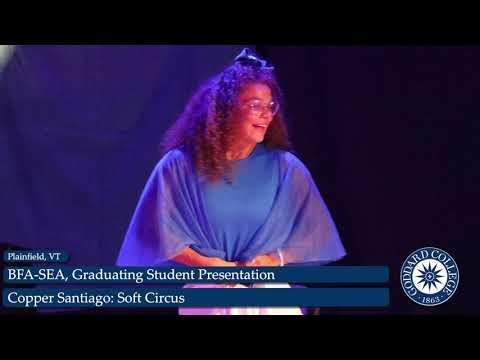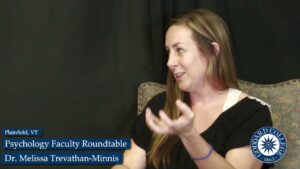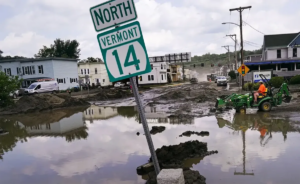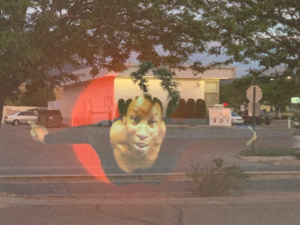
Photo by Jeb Wallace-Brodeur
In an historic gesture, Goddard College has gifted its beloved 1600 watt radio station WGDR/WGDH to the community of Central Vermont. The nonprofit organization Central Vermont Community Radio (CVCR), made up of dedicated WGDR/WGDH programmers and listeners, was formed for the explicit purpose of accepting the gift of the station.
Goddard President Bernard Bull, the staff of WGDR/WGDH, and a mix of legal helpers and supporters came together to implement the exchange. The signal, the towers, the equipment, are all now held in common by the CVCR and the programmers who bring their voices and talents to the airwaves every day.
Passing the Mic
Entering the Pratt Library on Goddard Colleges’s Plainfield campus, descending to the lower level, and winding around soundproof doors, you’ll begin to hear the sounds of broadcasting that have been transmitting for nearly 50 years.
WGDR/WGDH started as college radio, with a renegade spirit. Yet investment from the local Vermont community was inscribed into its mission since it began in 1972. When Goddard transitioned to a low-residency model in 2002, and students left campus, the station was passed entirely to the locals, with a mission to continue to bring the work of Goddard’s engaged faculty, staff, and students into the fold when possible. The station’s staff at the time advocated for Goddard, as the programmers joined the discussion of the College’s transition to the low-residency model that it invented and continues to innovate upon.
After 2002, the DJ chair was filled with 30-50 community volunteer programmers, many of whom graduated from Goddard and continued the continuity of the Goddard mission within the community. Joseph Gainza, serving as the Vermont Field Director of the AFSC, launched his public affairs call-in show Gathering Peace as part of his outreach effort,, now serves on the Board of Directors of CVCR.
“Goddard’s mission has always been to nurture and nudge students to find and use their authentic voice, to follow their passion and use it to build a more just world.” said Gainza, “In gifting the WGDR/WGDH licenses to Central Vermont Community Radio, Goddard is honoring that mission on a community scale.”
Visionary, Alternative Media
Students were clamoring for a signal as far back as 1963. They got a low-watt station, with a ten mile radius. The idea was abandoned when newly-constructed student housing, less than ⅓ mile away, couldn’t pick up the signal.
Even during that carrier-current broadcasting phase, the students and faculty operating the democratically-operated station were interested in making the community a central focus. A Goddard bulletin from 1964 stated, “We do not want the station to be a voice in itself, irrespective of the interests of community members. Our function is to maintain a broadcasting service open to interested groups and members of the community.”
The Alternative Media Conference, hosted at Goddard in 1970, gave birth to new ideas in the democratization of media. The AMC had community radio and video in mind as alternatives to the rising prominence of broadcast television and print. A turning point for hundreds of media makers and free speech advocates, the AMC inspired its attendees by forging a network of like-minded activists who went on to become innovators in their respective fields. The Conference would also amplify the student’s intentions for a student-run radio station.
On May 12, 1973, WGDR launched its first broadcast. With an 800 watt FCC license, and equipped with “record, tape and cassette playback”, there was a desire to broadcast Goddard’s mission and values onto the airwaves.
Reuben Jackson was 18 years old in 1975, and a student poet making his way through Goddard’s learner-driven study. As a WGDR programmer, Jackson embraced exacting pre-show rituals, an eclectic mix, and a programmer’s focused solitude.
“When the studio door closed, it stayed closed”, Jackson said. Jackson was a WGDR DJ for the next three years and became hooked on radio ever since.
He served as curator of the Smithsonian’s Duke Ellington Collection in Washington, D.C. for over twenty years and came to Vermont Public Radio where he became the soothing voice of the popular Friday Night Jazz for 5 years.
“When Marconi invented radio, he had stations like WGDR in mind. Soulful, informative, varied, and unpretentious programming. Voyages for the heart and mind. Thank goodness- some things never change.” said Jackson, a sustaining donor of CVCR.
A Broadcast Community
Joseph Gainza tells the story of the day the Plainfield community heard of the untimely passing of Adele Dawson. Adele was an herbalist and author of Herbs: Partners in Life: Healing, Gardening, and Cooking with Wild Plants. She was, by all accounts, a fierce and charismatic woman in Marshfield and deeply loved by her community. Though in her 80s, she was still in perfect health. She died suddenly at home one morning.
WGDR programmers were so stricken by the loss they dedicated the entire day to callers who wanted to tell their stories about Adele. The airwaves became an impromptu wake for the community to share its remembrances of a beloved member of the Plainfield’s community.
“It was community radio at its best as far as I’m concerned.” Gainza said. “And it happened because WGDR was here.”
Musician, educator, and Goddard alum Kris Gruen, was brought on as an interim station director in 2011 with the mission to reintegrate Goddard students, faculty and culture back into the community-run station. “When I started, WGDR was Goddard’s rebellious red-headed step child,” he said. Gruen’s interim position ended up becoming a ten year assignment.
Gruen’s first task in the role was to complete the acquisition of the station’s second signal tower, about an hour’s drive north of Plainfield. This acquisition would lead to the addition of another 900 watts, expanded listenership in Hardwick and Morrisville, 91.7 on the dial and WGDH to the call letters.
The station needed to reassert itself into the community, to gain listeners as well as supporters. Gruen and WGDR staff established training programs which helped promote journalism excellence and evaluations that modeled Goddard’s self-directed inquiry. The Indie Kingdom project, a collaboration with the Vermont Community Foundation, sparked national interest for its ability to connect youth voices, journalism and community stories. Goddard faculty Karen Werner and Goddard staff Josh Castle created a cross-department collaboration called True Stories with local high schools to support a credit-bearing program for youth that was co-funded by the State of Vermont. The station was intimately involved in a second Alternative Media Conference at Goddard in Spring 2013, and acted as media sponsor for the Haybarn Theatre Concert Series.
Gruen said that the most useful skill in being a director was bringing a genuine interest in connecting with people and cultivating the programmer’s individual process. “It helps having a musician’s ear,” he said.
Live and On the Air
The programmers who are charged with keeping the voice of WGDR/WGDH alive have all locked their commitment and craft into their weekly schedules.
“Magical Mystery Tour” embarks Fridays at 9am with Tonio Epstein. His introduction serves as the show’s mission statement: “Join us as we dive into the heart of things exploring new ideas, new ways of seeing and being in this wondrous and crazy world we share together.”
Alan LePage is a Goddard alum and farmer whose 30+ year program “Curse of the Golden Turnip” is followed by loyal listeners around the globe on wgdr.org. LePage’s program tackles “agricultural, horticultural and related political issues.” One recent broadcast highlighted the virtues of honeynut squash. “Honeynut combines the dryness of a buttercup with the sweetness and density of butternut.” Aside from the benefits of a crossing of cucurbita moschata with cucurbita maxima, LePage’s show tackles issues of climate change and how it affects local agriculture, flavored with the folksy charms of antediluvian Vermont farmer’s tales.
“Mocassin Tracks” is a program created by Deb Rieger described as “”pre-american” perspectives and music (traditional and contemporary), live interviews, and news featuring voices of the Original Peoples and often citizens of the Abenaki Nation.” Listenership is expanded by syndication with Pacifica Radio Network. Hopes and dreams for the future for the state’s recognized tribes are frequently discussed on her show. A broadcast of “Moccasin Tracks” concludes with this: “Thank you for supporting the Original Peoples – in art, music, respect and balance.”

Eben Markova-Gold is known as DJ Eben Flow. He has been rocking an eclectic mix of jazz, hip-hop, local music that then voyages into a heavy metal/industrial mix every Thursday night for 20 years. For him, WGDR/WGDH is a connection to an international community of music-lovers and metal heads.
“Every time I do a new show it is like meditation for me. Being a DJ on the radio creates so much joy and brightens up my week and my life. I know my listeners feel that way too.” Eben said. “The power of music is magic.”
The WGDR/WGDH programmers bring their unique style to their shows. They promote musical and poetic expression, the rigorous debate on topical local issues, and nuanced perspectives in the fight for social, racial and economic justice.
Along with news shows like Democracy Now, WGDR’s programs are the voice of the Central Vermont community. It is a voice broadcast heard in kitchens, backyards, car stereos and computers streaming around the world. The station also connects Central Vermont to the tight knit cohort of community-driven radio stations as a member of the Pacifica Radio Network and the National Federation of Community Broadcasters.
The Gift of Voice
Vermont Public Radio president and WGDR/WGDH sustaining donor Scott Finn believes the gifting of the station to the community is worth celebrating.
“I think Goddard deserves a lot of credit. WGDR fills a crucial need.” Finn said. “Community radio has the ability to have a conversion with folks who are right around the corner. Community media is accessible. Having community is about having conversations. It makes our lives richer and our community stronger. If you value it, support it.”
Llu Mulvaney-Stanak, aka DJ Llu, has been hired as a consultant to assist WGDR/WGDH with the transition to community radio and to keep momentum with fundraising efforts. Mulvaney-Stanak has their own personal connection with the station:
“My mom would often say that I had been a programmer since birth. In the early 1980s she did a show with my aunt and they would bring my twin sister and me as infants to their shows, stashing us under the broadcast board in a basket.” they said.
“I was very fortunate to be a teenage programmer from 1993-1998, after my mom sweet-talked Stu Bautz, the GM at the time, into letting her 13-year-old do a music show. I remember carefully recording my shows on cassette tape and listening back obsessively for the next 7 days to get my airchecks better and transitions tighter. WGDR sparked my life-long love of making radio.”
Llu and CVCR are stepping into an ambitious new era, one that requires even more community engagement. In order to kick start CVCR’s ownership, they’ve launched a “WGDR/WGDH 30×30” fundraising challenge, aiming to raise $30,000 in the first 30 days of the independence on the air. Supporters can donate to WGDR/WGDR here.
“It has been an honor to help this station continue and expand its role and legacy in the community. We hope that this gift to CVCR will sustain WGDR/WGDH well into the future,” Goddard President Bernard Bull said.
WGDR/WGDH is the soundtrack of social justice, environmentalism, multiculturalism, and responsible community action in Central Vermont. By being a listener, and contributing to this courageous broadcast, you become part of this transformative action. Read more from WGDR’s mission at wgdr.org.
Goddard College continues to give voice to its graduates, who are charged with making impactful change in the communities they serve. Our community of learners are from every background, near and far, and at various stages of their lives. It’s never too late to bring your unique voice to the table. Find out more by making an admissions inquiry at admissions@goddard.edu.
This article was written by Ben t. Matchstick, Digital Media Coordinator for Goddard College. All interviews were conducted in May 2021. Contact him on Twitter @bentmatchstick







